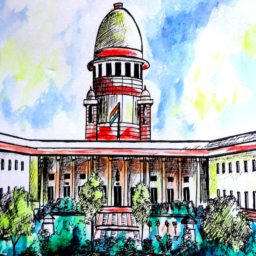
In our democracy, the institutions that we believe in are being continuously changed because we are never satisfied with them. The makers of the constitution always had the thought of keeping the constitution not too rigid and give scope for flexibility, so that corrections could be made as per the needs of the present. From time to time the amendability of the fundamental rights has been challenged but there were always limitations placed under the constitution of India. So, with the help of cases, I will explain below how the constitution of India faced questions over the amendments of fundamental rights. I will also answer if they are amendable or not and if they are then how.
After the formation of the Constitution, the power to amend the constitution was given under Article 368. This article can be interpreted in the given way (i) the power to amend the constitution by the parliament is absolute and there are no limits placed on that power (ii) Parliament should not take the power of the courts to strike down amended legislation. I want to clarify to the readers, this Article states what was present just after the formation of the Constitution. There have been amendments to this Article which shall explain later in the paper.
Now, the main question was, whether fundamental rights are amendable or not, as they might take away the basic rights which are guaranteed under the constitution of India. Also, if the Parliament has the authority to amend such laws. The supreme court from time to time has answered this which can be understood in the light of the following cases given below.
In the case of ‘Shankari Prasad vs Union of India,’[1] the argument was put forward that as per the provisions of Article 13 if no law can infringe the fundamental rights then how can the constitutional amendment violate it. The apex court upheld the validity of the first amendment in this case. The court had rejected the contention and limited the scope of Article 13 by saying that the word ‘law’ would not be included within the scope of the constitution as an amended law under Article 368. It said an amendment is now a law within the meaning of Article 13(2).
At that time the courts were fine with fundamental rights being amended as their logic was that an amendment is not a law so it’s valid.
For the next 16-17 years, the Shankari Prasad case was dormant when a discussion over the amendment of fundamental rights held. In 1964, the question over the validity of the 17th Amendment Act was challenged. In the case of ‘Sajjan Singh vs the State of Rajasthan,’[2] this amendment was challenged because this amendment affected the right to property which placed a few rights in the 9th schedule. Here, it was challenged that the amendment fell under the scope of Article 368 which had not been properly complied with. The Supreme Court rejected this argument by reiterating the Shankari Prasad case and stated that the power given under Article 368 can be exercised over any law that falls under the Constitution of India.
Now comes the case of Golakhnath. In the case of ‘Golakhnath vs the State of Punjab,’[3] the position adopted in the above-mentioned cases was rejected. The court overruled the above decisions and held that the Parliament under Article 368 had no power to amend part III of the Constitution. The court observed that Article 368 merely lays down the procedure for the amendment. The court here rules that the term ‘law’ in a more comprehensive sense would include constitutional law as well as Article 13(2). The main propositions that were drawn in this case were (i) Article 368 only contains the procedure for an amendment (ii) the word ‘amend’ means only minor changes to the existing provisions and not any major changes (iii) if you have to amend the fundamental rights, the Parliament should convene a constituent assembly.
Golakhnath case created a lot of issues in the judiciary as well as the Parliament, due to which the Parliament enacted the 24th Amendment Act which changed the provision Article 368 from ‘procedure’ to ‘power’ of the Parliament to amend the Constitution. After this, a lot of questions were raised due to which a 13-judge constitutional bench was formulated where it was observed that “The Supreme Court overruled its decision in Golaknath’s case and held that even before the 24th Amendment, Article 368 contained power as well as the procedure for amendment. The majority held that there are inherent limitations on the amending power of the Parliament and Article 368 does not confer power to destroy the Basic Structure of the Constitution.”[4]
Now in the famous case of ‘Kesavananda Bharti vs State of Kerala’[5] Kesavananda Bharti whom a chief of a Mutt in Kerala challenged the constitutional validity of the 24th and 24th amendments through a writ petition in the Supreme Court. Here the 13-judge headed bench gave the following observations:
- The court clarified that in Golakhnath’s case it was clear that Article 368 provides the power to amend and not the process to amend.
- The court distinguished between a normal law and a constitutional law.
- It was not clear that an amendment cannot destroy the basic structure of the Constitution, any amendment which affects the basic structure shall be deemed to be ultra vires.
After this scenario, the ‘theory of basic structure’ was proved to be a limitation over the amending powers of the Parliament. This doctrine applied only to the constitutionality of the amendments and not to the normal provisions of the Parliament. Chief Justice Sikri had observed that the basic structure means (i) supremacy of the constitution (ii) secular character of the constitution (iii) federal character of the constitution (iv) maintenance of separation of powers (v) republican and democratic form of government.
It was also clear that “the courts have the power to call into the question of whether the amendment is against the principle of the basic structure or destroys any fundamental feature of the Constitution. If an amendment does so, it will be constitutionally invalid.”[6] Here, Justice Khanna said that the power of amendments under Article 368 did not include the power to abrogate nor did it include the power to destroy the basic structure of the Constitution.
Then in 1976, the 42nd Amendment Act was passed by the Parliament. Here the amendment added to clause 4 and clause 5 to Article 368. “Article 368(4) provided that no Constitutional Amendment shall be called in any court on any ground. Article 368(5) provided that there shall be no limitation whatsoever on the constituent power of the Parliament.”[7] In the case of ‘Minerva Mills vs Union of India’[8] the court struck down the clauses inserted by the way of the 42nd amendment and the justification given by the court was that these clauses were violative of the basic structure of the constitution. It said that the limitation of the amending power should be understood as per the Kesavananda Bharti case.
There have been various instances where the basic structure has been proved by the court so that it is not violated by any other provision like the case of ‘Indra Nehru Gandhi vs Raj Narain’[9] here the validity of the 39th amendment was questioned and the concept of the basic structure was affirmed. Again, in the case of ‘L. Chandra Kumar vs Union of India’[10] the court had struck down various clauses of Article 323 as it violated the basic structure of the constitution.
The present legal position over the amendment of fundamental rights stands as per the Kesavananda Bharti Case, where the fundamental rights, in general, can be amended as per Article 368 of the Indian Constitution but if any particular fundamental right is considered to be a basic feature then that fundamental right cannot be amended or taken away. Articles 14,21 and 32 have been considered as the basic structure, so they cannot be abridged. I would like to conclude by saying that to avoid irregularities or inconsistencies on the basic structure of the constitution as well as Article 368, there should be recourse on it to effect amendments in part III of the Constitution. This could be the only way that the flexibility over the fundamental rights can be achieved to meet the changing social circumstances in this socio-economic democratic country.
Author(s) Name: Ayush Shukla (Jindal Global Law School, Sonipat)
Reference(s):
[1] (AIR 1951 SC 458)
[2] (AIR 1965 SC 845)
[3] (AIR 1967 SC 1643)
[4] Chief Justice Sikri headed this bench and gave the judgement
[5] AIR 1973 SC 1461
[6] Ibid
[7] 42nd Amendment Act, Constitution of India, also known as the Mini Constitution
[8] (AIR 1980 SC 1789)
[9] (AIR 1975 SC 2299)
[10] (AIR 1997 SC 1125)















